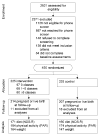Active Mothers Postpartum: a randomized controlled weight-loss intervention trial
- PMID: 19595557
- PMCID: PMC2774935
- DOI: 10.1016/j.amepre.2009.05.016
Active Mothers Postpartum: a randomized controlled weight-loss intervention trial
Abstract
Background: Pregnancy may contribute to overweight and obesity.
Purpose: The primary objective of Active Mothers Postpartum was to promote a reduction in BMI through 24-months postpartum via sustainable lifestyle changes.
Design: Behavioral intervention RCT to enhance postpartum weight loss.
Setting/participants: A total of 450 overweight or obese women, enrolled 6-weeks postpartum, were recruited through obstetrics clinics and community posters in the Durham NC area.
Intervention: Intervention participants were offered eight healthy-eating classes, ten physical-activity classes, and six telephone-counseling sessions over 9 months.
Main outcome measures: Changes from baseline (6-weeks postpartum) to 1-month post-intervention (12-months postpartum) in: (1) diet (caloric intake, calories from fat, intake of certain foods); (2) physical activity (self-reported physical activity, television time); and (3) weight (collected 2004-2007, analyzed 2007-2008).
Results: Mean weight loss was 0.90 kg (+/-5.1 kg) in the intervention group and 0.36 kg (+/-4.9 kg) in the control group; this difference was not significant. There were also no significant group differences in improvement of diet or increased physical activity. In secondary analyses, there was a positive bivariate relationship between classes attended and weight loss (p=0.01).
Conclusions: There were no significant differences among the arms in diet, physical activity, or weight change. Home-based interventions via mail, telephone, or Internet/e-mail may be more feasible and successful in this population. The postpartum period is an important phase in women's lives with regard to weight retention, but engaging them during this busy period remains a challenge.
Trial registration: NCT00212251.
Figures
References
-
- Williamson DF, Kahn HS, Remington PL, Anda RF. The 10-year incidence of overweight and major weight gain in U.S. adults. Arch Intern Med. 1990;150(3):665–72. - PubMed
-
- Gunderson EP, Abrams B. Epidemiology of gestational weight gain and body weight changes after pregnancy. Epidemiol Rev. 1999;21(2):261–75. - PubMed
-
- Crowell DT. Weight change in the postpartum period: a review of the literature. J Nurse Midwifery. 1995;40(5):418–23. - PubMed
-
- Gore SA, Brown DM, West DS. The role of postpartum weight retention in obesity among women: a review of the evidence. Ann Behav Med. 2003;26(2):149–59. - PubMed
-
- Gunderson EP, Abrams B, Selvin S. Does the pattern of postpartum weight change differ according to pregravid body size? Int J Obes. 2001;25:853–62. - PubMed



